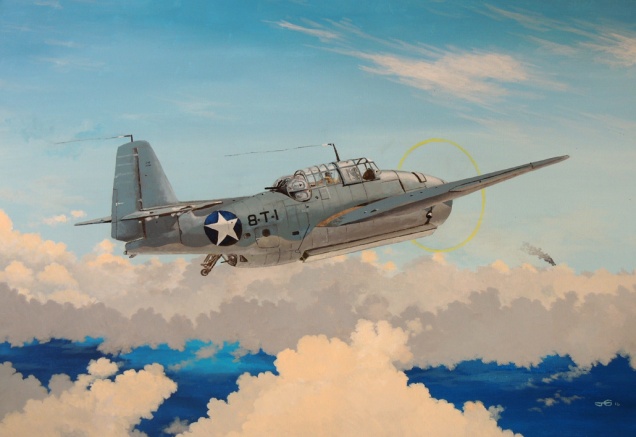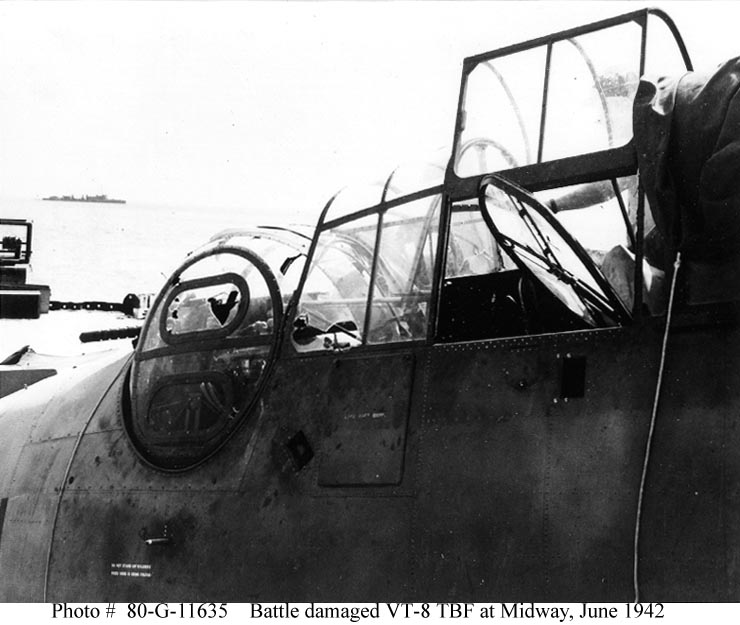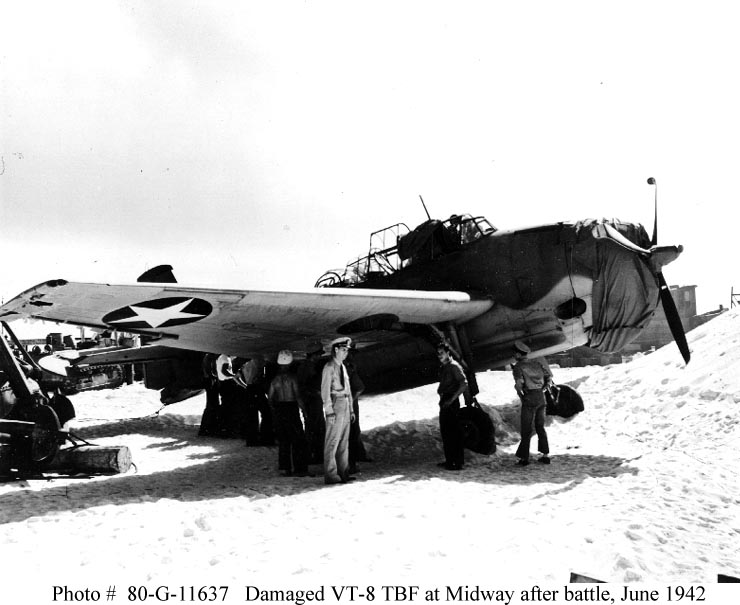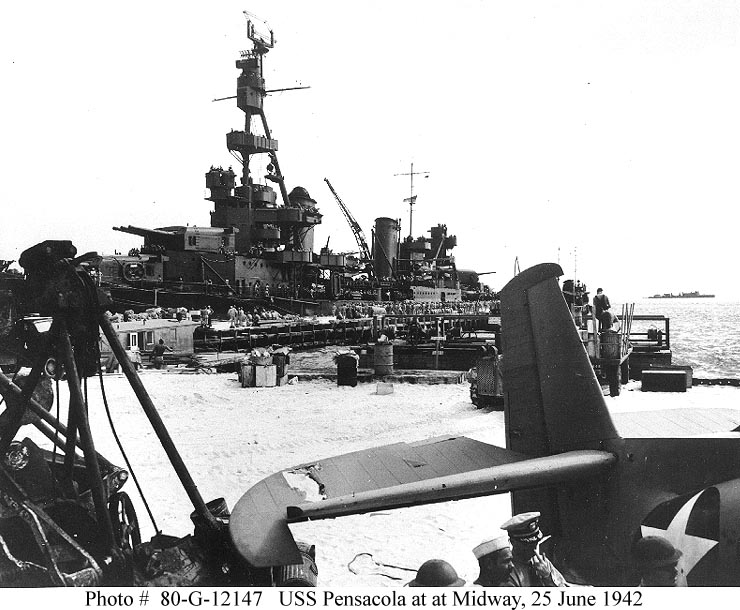
Collection John Leonard Greaves
The following was taken from the Internet
Torpedo Eight: The Other Chapter
By Commander Harry H. Ferrier, U.S. Navy (Retired)
The gallant but little-known role of a six-plane all-volunteer TBF detachment, of which the author and his pilot were members, adds further to the record of the sacrifices made during the Battle of Midway. Much has been told of the heroic sacrifice of Torpedo Squadron Eight at the Battle of Midway. The gallantry of its officers and men in the face of overwhelming odds is indelibly inscribed in the history of the U.S. Navy. The fame of Torpedo Eight has rested on the actions of the main body of the squadron based on board the USS Hornet (CV-8). Yet, there is another chapter to this story, which has received little mention and deserves telling before memories have faded beyond recall.
Torpedo Squadron (VT) Eight was commissioned at Norfolk, Virginia, in the late summer of 1941 as an element of Carrier Air Group Eight, better known then as the Hornet Air Group. The ceremony took place in front of an old World War I hangar at Chambers Field on the air station. East Field, which is now the operating portion of Naval Air Station (NAS), Norfolk, had not yet been completed. The squadron’s first commanding officer—who also led their fateful flight—was Lieutenant Commander John C. Waldron, a veteran of more than 20 years of naval service.
The first aircraft assigned to the squadron were SBN-1s. These planes were a mid-wing design of the Brewster Aircraft Company, manufactured by the Naval Aircraft Factory, Philadelphia. They were used to provide pilot training for our newly commissioned squadron as there was a shortage of TBD-1 Douglas Devastators and the TBF-1 Grumman Avenger had not yet reached the production stage. The rest of the air group was little better equipped; the bombing and scouting squadrons were assigned Curtiss SBC-4 Helldivers, a mid-1930s biplane design.
I reported to the squadron on 7 September 1941, a green but enthusiastic radioman striker fresh from the aviation radio school at NAS, Jacksonville, Florida. I was only 16 years old. I enlisted on 28 January 1941, five days after my 16th birthday. My mother’s friend had a typewriter, and she changed my birth year on the forms.
On my first flight, we attempted to locate a mobile direction-finder station which was somewhere in the Dismal Swamp area. At the time, we had only manual direction finders, which required some skill to operate. Because the pilot and I were both new at this challenging exercise, our success was something less than spectacular. It was not long, however, before gunnery, torpedo tactics, bombing, and field carrier landing practice were familiar and meaningful terms to me. Our training progressed satisfactorily, and in October we received a few TBD-1s. The Japanese attack on Pearl Harbor that December and our immediate entry into war caused a rapid acceleration of training, culminated by a month-long shakedown cruise by the Hornet and her embarked air group in January 1942.
Shortly after our return to port, it was decided to form a detachment of approximately 80 officers and men who would remain in Norfolk and take delivery of the first TBF-1s. The Hornet, with the main portion of the squadron, left immediately for the Pacific. That March, members of our detachment were sent to the Grumman factory on Long Island to learn as much as possible about the airplane from the engineers and builders—this was in the days before the Naval Air Technical Training Command mobile trainers and the Fleet Indoctrination Program. It was an interesting experience, but the knowledge we gained was very limited.
In the latter part of March we received and flew our first of 21 shiny new Grumman Avengers. (The Avenger was not so named until after the Battle of Midway to recognize the mission and dedication of all torpedo squadrons—to avenge the heroic sacrifice of their predecessors.) We were all impressed with the new plane’s speed, maneuverability, and ruggedness.
At Quonset Point, Rhode Island, we made our first high-speed launches of a newly designed torpedo, which was capable of surviving drop speeds of 125 knots and 125-150 feet of altitude. This, we knew, would give us an advantage over the TBDs with their 100-knot, 100-foot attack capability. After only a few days of the test program had been completed, we were recalled to Norfolk and told to fly our planes across the country to join the Hornet and our shipmates in the Pacific. After an uneventful crossing from San Diego to Pearl Harbor in the USS Kitty Hawk (AKV-1), a converted railcar transport, we unloaded our TBFs at Ford Island and began preparing them for shipboard duty. The Hornet was then at sea. Within hours after our arrival a call went out for volunteers to fly six planes to Midway Atoll. The mission was not stated, but there was little doubt that some action was in the offing. There was no difficulty in obtaining volunteers, and I counted myself lucky to have been one of those chosen.
Bright and early on the morning of 1 June we took off from Ford Island for the eight-hour, 1,300-mile flight to Midway—a little dot in the ocean, northwest of Hawaii. Lieutenant Langdon K. Fieberling led the detachment. I was assigned to fly with Ensign Albert K. Earnest as his radioman and tunnel gunner; our turret gunner was Aviation Machinist’s Mate Third Class J. D. Manning. We flew off Lieutenant Fieberling’s wing in the first section of three airplanes. The six planes were guided by two navigators from Patrol Squadron 44 on board the two section leaders’ aircraft: Ensign Jack Wilke flew with Lieutenant Fieberling and Ensign Joseph Hissem with Ensign Oswald J. Gaynier. The flight was uneventful to the point of monotony.
As soon as we arrived we could feel a tension in the air. We were all sure that a meeting with the enemy was not far off. Many planes of all types were in evidence—Brewster F2As, Grumman F4Fs, Douglas SBDs, and Chance Vought SB2Us, all flown by Marines; and Boeing B-17s, Consolidated B-24s, and Martin B-26s being flown by the Army Air Forces. The B-26s were equipped as torpedo planes, carrying their “fish” externally below the bomb bay. And, of course, the venerable Consolidated PBYs were present. We quickly prepared our planes for combat, which included loading six of the new type of torpedoes, which we had been testing so recently. They had been transported to Midway under the wings of the PBYs. We all were exhilarated by the prospect of meeting the enemy. I’m not certain now why we did it, but we put patches of masking tape on the leading edges of our wings and painted black circles on them too simulate gun ports. I know we were not particularly impressed with the effectiveness of the single .30-caliber machine gun, which was synchronized to fire through the propeller arc. We had much greater confidence in the .50-caliber turret gun and .30-caliber tunnel gun, which covered our rear.
That evening Lieutenant Fieberling called us together and quickly confirmed our suspicions that something momentous was about to happen. He said the Navy believed that a Japanese thrust in the direction of Hawaii was imminent and that Midway Atoll was most certainly a target of that push. We were also told that the Navy expected the Japanese to attack the Aleutian Islands but that this would be merely a diversionary tactic to draw our ships away from the sea around Midway and Hawaii. For the next two mornings, we were up at 0400, warming our engines and then standing by on alert until 0700. The rest of the time was spent exploring the island and chasing Gooney birds. We camped on Eastern Island, which was then nothing more than a long, low strip of sand, with the runway taking up almost its entirety. Aircraft parking revetments, tents, and a scattered collection of wooden buildings occupied what little space remained.
On the morning of 4 June, we were up and manning our planes at 0400 as usual. About an hour after we shut down, a Marine officer came running to our plane and told us to start our engine. He stated that unidentified aircraft had been sighted about 100 miles away by a patrol plane. We started up and joined the other planes of our group taxiing out to the take-off spot.
Immediately after taking off, we joined with the others in two sections of three planes each, climbed to 2,000 feet, and headed out on a course of 320 degrees True at 160 knots. Very shortly after takeoff, a single pass was made at us by two or three Japanese planes, one of which Ensign Earnest tentatively identified as a Messerschmitt 109, a plane that was reputedly being flown by the Japanese. In all probability, the enemy planes were Zeros or Vals from the force that was heading in to attack Midway. After this brief encounter, we climbed to 4,000 feet and continued on our original course.
We sighted the enemy carrier force at approximately 0700 from about 15 miles away. In his postbattle report, Ensign Earnest reckoned their number at ten ships. In reality there were 21 ships in the formation, including four carriers. Almost simultaneously with our sighting of the enemy we were attacked by their combat air patrol.
It was evident at once that we were outnumbered. Our pilots immediately pushed over into a dive and applied full throttle to the engines. On the second firing pass by the attacking Zeros, our turret gunner, Manning, was hit and his turret put out of action. I remember looking over my shoulder to see why he had stopped firing. The sight of his slumped and lifeless body startled me. Quite suddenly, I was a scared, mature old man at 17. I had never seen death before, and here in one awesome moment my friends and I were face-to-face with it. I lost all sense of time and direction but huddled by my gun hoping for a chance to shoot back.
At one point in the battle I glanced out of the small window on my left and saw an airplane streak by on fire and enter a cloud. The glance was so fleeting that I had no chance to identify it. Unfortunately, it later proved to have been one of ours.
The attacking fighters outnumbered us by at least three to one and it soon became evident that they did not intend for any of us to survive. Another pass and I was out of the fight—our hydraulic system had been hit and the tail wheel was now blocking my gun’s field of fire. I felt a searing pain in my left arm as a bullet grazed my wrist. It was shortly after this that I was struck a stunning blow on the head and lost consciousness. I shall always remember coming to and viewing through bleary eyes a stream of blood that was rapidly coloring my gun an ugly red. Gingerly I fingered my scalp. After some moments I decided that maybe I was not going to die after all, but I was still unable to contribute anything to the battle.
I was never aware of just how precarious our position was until after the battle. Some few miles short of the enemy carriers, our elevator control cables were severed, and the plane began rapidly plunging toward the water. With foresight, Ensign Earnest had opened the bomb bay doors at the first attack. Thinking that we were now out of control, he released our torpedo in the direction of a light cruiser and hoped for the best.
Just before we hit the water, he regained altitude control by using the trim tab. Our salvation was by no means assured, as two Zeros continued to press home their attacks. About ten minutes later, apparently having run out of ammunition, our two tormenters finally turned away and returned to their carrier. As he glanced back toward the force, Ensign Earnest was unable to see any damage to the Japanese ships, as indeed there was none. Ours was the first of many futile attacks by a total of 51 torpedo planes. Only seven of these planes survived the suicidal assaults.
There still remained the problem of returning to Midway, which had not been made any easier by the loss of our compass system as well as the previously recounted control difficulties. No provision had been made for a standby compass. Ensign Earnest’s only means of navigation was the sun and the knowledge that we departed from Midway on a generally westerly course.
Some time later as we were heading back toward Midway, I crawled up over the bomb bay compartment and sat in the seat immediately behind the pilot. Much later I saw a huge column of black oil smoke seemingly rising from the sea. This proved to be Midway’s Sand Island fuel dump ablaze. It was a most welcome sight.
Compared to the battle, our landing was fairly smooth even though it was made on only one main wheel, without flaps, the bomb-bay doors open, and limited elevator control available. At least we were able to walk away from it.



A TBF had survived its baptism of fire and proved itself a rugged, worthy replacement for the TBDs, which had been almost completely eliminated from the Navy inventory on the day of the battle. I made a deliberate effort to remember the bureau number of the plane in which I saw so much of this battle. It was TBF-l BuNo 00380, the first plane delivered to the squadron; it bore the side number 8-T-1. I have often wondered since then if our attackers made any greater effort to get us because of our side number, or if they were aware of it and its significance. The plane was later returned to Pearl Harbor and examined.

Engineers identified 64 machine-gun bullet and nine 20-mm cannon hits on the airplane. More bullets may have hit, but they were masked by the wider damage of the cannon hits.
Of the six TBFs from the Midway detachment and 15 TBDs from the Hornet that Torpedo Eight launched against the Japanese, ours was the only plane to survive the battle. But our ordeal had not yet ended since we still had to accept the irrefutable loss of our companions. It was my sad task, along with Aviation Machinist’s Mate First Class William L. Coffey Jr. (who had not flown on the mission), to take inventory and pack their few personal possessions—a treasured book of poems, letters, and pictures of sweethearts and families—all of them mirroring somehow their owners.
We did not know until much later just how terrible, yet triumphant, the sacrifices had been that day. The futile attacks of Torpedo Squadrons Three, Six, and Eight, and the work of the four Army B-26s had unalterably sealed the fate of the Japanese carriers. Our fellow fliers in the bombing and scouting squadrons were thereby able to attack the Japanese when they were most vulnerable-while rearming and refueling their aircraft.
Commander Ferrier served briefly in VT-3 and VB (Bombing Squadron)-5 on board the USS Yorktown (CV-5) after his assignment to VT-8. He was commissioned in January 1945, and later served in three heavy-attack squadrons, the USS Princeton (LPH-5), and Patrol Squadron 2. He now resides in Oak Harbor, Washington.
Next, Commander Ferrier’s retelling of events at the Battle of Midway.
https://www.youtube.com/shared?ci=1mx8LNNTN8M
http://harryferrier.blogspot.ca/2009/06/i-have-privilege-to-have-helped-harry.html?m=0
I can not imagine this world without the Greatest Generation around for advice and strength.